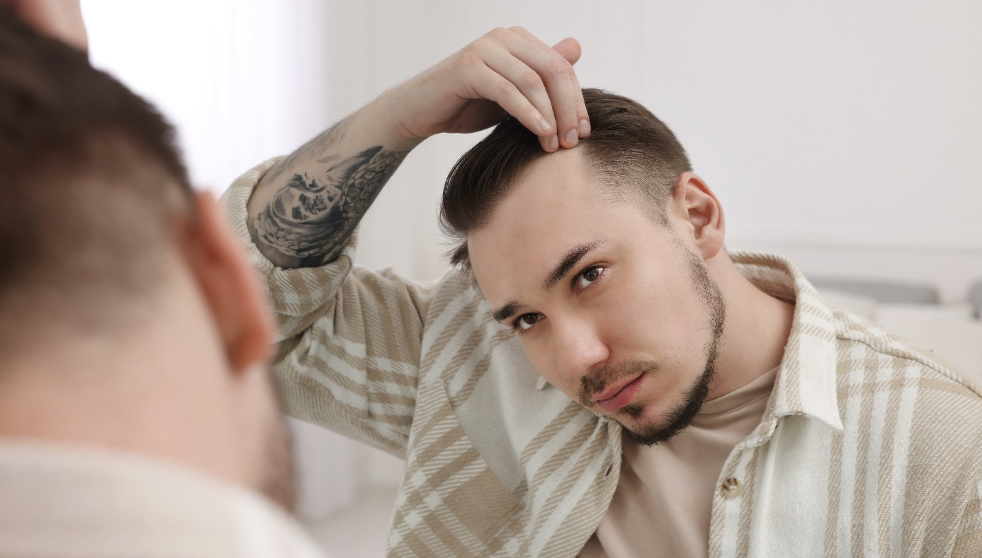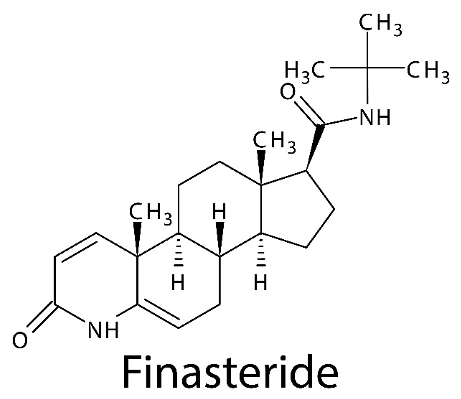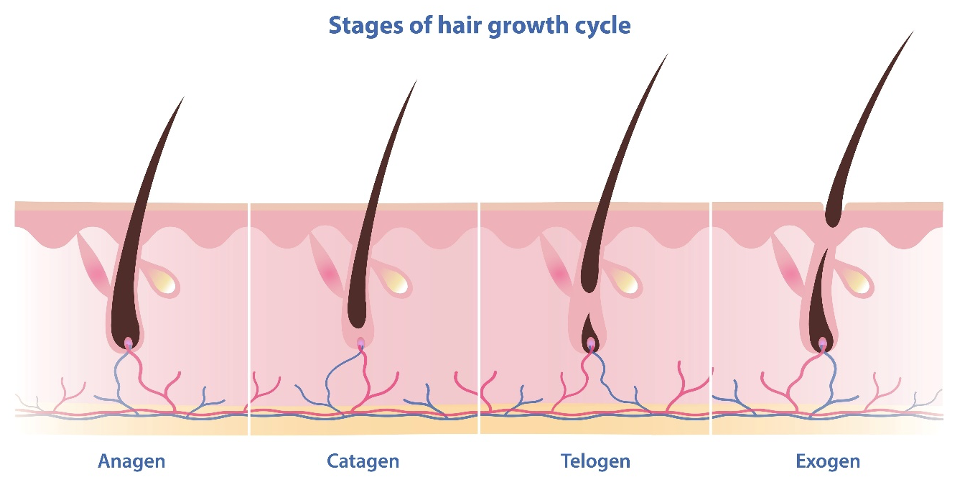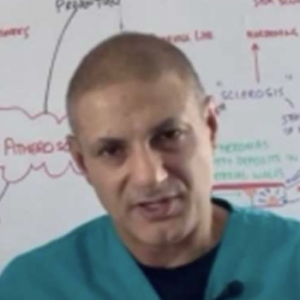You wake up and stumble to the mirror, but what stares back at you can’t be your reflection. Who is that guy with the receding hairline, you wonder? Then, with a sinking realisation, you discover it is, in fact, you.
We are often so wrapped up in our hectic schedules that we overlook the first signs of male pattern baldness until it suddenly creeps up on us when we are least prepared. Only then do you remember reading blogs with titles like “How long does it take finasteride to start working?”

But before we attempt to answer this question in more detail, let’s break down what this blog will cover.
Table of contents
- Finasteride, the good news and the bad news
- What is androgenetic alopecia or male pattern baldness?
- What causes male pattern baldness?
- 5-alpha reductase inhibitors can reduce hair loss
- Summary of the safety and efficacy of finasteride for hair loss
- How finasteride works?
- Why does it take so long for finasteride to work?
- What to expect on your finasteride journey
- Months 1 to 3: Finasteride begins the war against hair loss
- Months 3 to 6: Starting to see results
- Finasteride year one: Visible and encouraging progress
- Long-term benefits of finasteride
- 5-year study comparing finasteride to placebo
- Summary
Finasteride, the good news and the bad news

The initial horror of a reflection of receding hairline heralds the onset of the slow progressive loss of hair follicles, eventually ending with the classic balding scalp characteristic of male pattern baldness. Fortunately, we can stop this slow descent into the follicular desert atop our scalp with approved medicines to stop hair loss and encourage growth.
Once you begin your search for hair loss treatments, you will soon come across the wonder drug finasteride, an FDA and MHRA-approved medicine for hair loss that is backed by robust scientific evidence. Numerous studies have demonstrated real hair count and thickness improvements when taking finasteride [1]. Once you discover this panacea for balding, the next question to naturally ask is, how long does finasteride take to start working? This is what this blog will attempt to explain.
In this article, we will explore how long it takes for finasteride to work and the typical timeline for visible results to appear. With finasteride it’s a case of some good news and some bad news. The good news, which has already been mentioned, is that finasteride is a proven treatment with a solid scientific pedigree in preventing hair loss and promoting hair growth. The bad news is that it’s also a case of good things come to those who wait. Getting the best results from finasteride will take months; it’s not the overnight success that every man hopes for, but with patience and persistence, the results can be impressive.
Let’s now have a quick primer on androgenetic alopecia or male pattern baldness for us non-endocrinologists.
What is androgenetic alopecia or male pattern baldness?
Androgenetic alopecia (AGA), often called male pattern baldness, is a common condition where genetics cause hair to thin and recede over time. In men, this usually appears as a receding hairline and thinning on the top of the head, leading to ongoing hair loss [2].

What causes male pattern baldness?
Male pattern baldness or androgenetic alopecia (AGA), the leading cause of hair loss, occurs because of a hormone called dihydrotestosterone (DHT). This hormone is created when an enzyme called 5?-reductase converts testosterone into DHT. Once DHT attaches to specific receptors in your hair follicles, it interferes with the signals needed for hair growth. As a result, the cells responsible for growing hair stop working properly, leading to the thinning of hair or hair loss [3].
Over time, hair follicles that are genetically prone to androgenetic alopecia begin to shrink. Instead of producing thick, healthy hair, they start making much finer, thinner strands [4]. Along with this, the hair growth cycle changes—the growth phase (anagen) gets shorter while the resting phase (telogen) becomes longer. Since the length of the growth phase determines how long your hair grows, the result is shorter, thinner hair. Eventually, this leads to noticeable thinning or bald spots [5].
5-alpha reductase inhibitors can reduce hair loss
Here’s the good news: by blocking the 5-alpha reductase enzyme with medications like finasteride, we can reduce the amount of DHT in the body, helping to stop hair loss and even encourage new growth. Sounds great, right?
But as with most things, there’s a catch. Finasteride, while effective in blocking DHT in the hair follicles, can also cause side effects when DHT levels in the blood plummet. Although mostly well tolerated, it comes with a list of potential side effects, including erectile dysfunction, problems with ejaculation and lowered libido or sex drive [6], which understandably makes some men hesitant to take finasteride. It’s a trade-off—great results for your hair but possible downsides for other parts of your health.
Summary of the safety and efficacy of finasteride for hair loss
Finasteride, commonly marketed as Propecia, is a widely used 5?-reductase inhibitor for treating male pattern baldness (androgenetic alopecia). This medication has a proven track record in treating male pattern baldness, but with its increasing use, a number of side effects are beginning to surface. We have already mentioned the potential adverse effects associated with male reproductive health, but another worrying development is the possible association with depression. This has led to more studies being carried out on finasteride use in hair loss, but unfortunately, the results are a mixed bag. While some studies demonstrate a low incidence of these adverse effects, others highlight potential risks, especially with extended use.

Topical finasteride is being explored as an alternative. It offers similar benefits for hair growth with fewer systemic side effects compared to the oral form. However, more research is needed to establish its overall effectiveness and safety. To read about this development read our blog about how to reduce the side effects of finasteride.
While finasteride is one of the most effective treatments for male hair loss, the conflicting evidence on its side effects makes it essential for users to weigh the potential risks before starting treatment. However, despite these concerns, reports of severe adverse effects remain relatively rare in clinical practice [7]
How finasteride works?
Finasteride belongs to a group of medications called 5-alpha reductase inhibitors. It works by blocking an enzyme called 5-alpha-reductase. This stops your body from converting testosterone into dihydrotestosterone (DHT)—the hormone responsible for male pattern baldness (androgenetic alopecia) and conditions like benign prostatic hyperplasia (BPH, or enlarged prostate).
Although finasteride works quickly in your system, lowering your DHT levels as soon as it’s active, you’ll need to be patient for visible results. It usually takes about three to four months before you start noticing a difference, and the full effects take around a year to show. This seemingly paradoxical situation is where we will now turn.
Why does it take so long for finasteride to work?
Why does it take so long to see results? I’ll give you a clue: it has to do with how our hair grows. Let’s quickly review our hair growth cycle.
Hair growth has four unique stages, which are:
- Anagen (Growth Phase): This is the active growth phase of hair follicles, during which the cells divide rapidly in the hair’s root. This phase can last for several years and determines the hair’s length.
- Catagen (Transition Phase): This short phase lasts about 2-3 weeks. During this time, the hair follicle shrinks and detaches from the dermal papilla, which is responsible for supplying nutrients to the hair follicle.
- Telogen (Resting Phase): This phase lasts around three months. During this phase, the hair does not grow but does not fall out either. The hair follicle remains dormant, and the detached hair remains in place.
- Exogen (Shedding Phase): This is the phase where the hair is released and falls out. A new hair begins the growth phase, pushing the old hair out of the follicle, and the cycle restarts.
These phases occur asynchronously; at any given time, different hairs on the scalp could be in different phases of the growth cycle.

It’s precisely because hair growth follows this four-phase cycle that the results from finasteride are not instantaneous. It takes time for new hairs to grow from the root to a noticeable length. Results from finasteride aren’t immediate, but you can rest assured that this DHT blocker is hard at work in the background. You’ll usually notice a slow, steady improvement over several months as your hair starts to regrow and thicken.
So, if you are thinking of starting finasteride, don’t expect overnight success. Be patient and persistent, and the results will speak for themselves after a year. Let’s break down the year so you know what to expect at each milestone.
What to expect on your finasteride journey
We know finasteride reduces your DHT levels, but by how much? Studies have demonstrated that finasteride reduces serum DHT levels in the body by about 70% [8]. This is a pretty large fraction of DHT taken out of action inside the body, yet no changes are visible on the outside. While the noticeable changes may take about 3-4 months to occur, finasteride gets to work right away by cutting down DHT production. This not only slows down hair loss but also kick-starts new hair growth. Let’s see what kind of growth you can expect in months 1 to 3.
Months 1 to 3: Finasteride begins the war against hair loss
From the moment you take your first finasteride 1mg tablet or apply your compounded finasteride hair loss liquid or foam, DHT levels in your blood immediately begin to fall. Less circulating DHT means there is less of it to mess with your precious hair follicles. Let’s see what the studies say about how much the DHT levels are reduced.
Drake et al. (1999) found that after 42 days of treatment, DHT levels in the scalp dropped by 64% with 1 mg and 69% with 5 mg of finasteride, compared to just a 13% decrease with a placebo. In the bloodstream, DHT levels fell by 71% with 1 mg and 72% with 5 mg, while the placebo group actually had a slight 1% increase. The study also showed that even at low doses like 0.05 mg per day, finasteride significantly reduced scalp DHT, but doses of 0.2 mg or higher were the most effective at lowering DHT levels in both the scalp and blood [9].
So, what does this initial reduction in DHT levels mean for your hair growth? If you are just using finasteride, you will probably see little to no noticeable hair growth in this period. Remember, this is simply an effect of the growth cycle stages that each hair has to go through. So, while some new hairs are in their anagen or growing phase, others may be in their exogen or shedding phase.
During this time, it is important to maintain your morale and maybe visualise the silent campaign that finasteride is waging against DHT in your hair follicles. This is also why it is a good idea to combine finasteride with minoxidil, so while one works quietly behind the scenes, the other starts pushing new hairs out sooner. If you don’t fancy popping more than one pill, you can try our range of compounded finasteride and minoxidil combinations:
- Finasteride 0.1% minoxidil 5% hair loss liquid
- Finasteride 0.1% minoxidil 5% hair loss foam
- Finasteride 0.1% minoxidil 10% hair loss liquid
- Finasteride 0.1% minoxidil 10% hair loss foam
- Finasteride 0.05% minoxidil 5% hair loss liquid
- Finasteride 0.05% minoxidil 5% hair loss foam
- Finasteride 0.05% minoxidil 10% hair loss liquid
- Finasteride 0.05% minoxidil 10% hair loss foam

Months 3 to 6: Starting to see results
By the time you hit the three—to six-month milestone, you may begin to start noticing that your hair loss has either slowed down or stopped altogether. If you have a receding hairline, then you may even begin to see visible improvements. So, what do the studies tell us about hair growth in this time period?
A 2004 study found that men treated with finasteride for 12 weeks showed significant improvement in their hair loss [10].
In another study which looked at the efficacy of topical finasteride, at week 12, a statistically significant increase from baseline in total area hair count relative to placebo was observed with topical finasteride [11]
Use these initial positive results to bolster your resolve to keep going. Remember, with finasteride and hair loss, it’s a marathon, not a sprint.
Finasteride year one: Visible and encouraging progress
You’ve done it! You’ve reached the one-year milestone. Go ahead and look in the mirror. Now, when you stare at your reflection, you will no longer recoil in horror but can now spend time running your fingers through your rejuvenated scalp. Numerous studies confirm that a year into using finasteride, most men see significant gains in hair count and thickness and a noticeable slowdown in hair loss. In fact, an impressive 65% of men using finasteride experienced some form of hair growth after one year[10].

*Not actual results!
Remember, everyone is unique, and responses may differ. While some men experience fantastic hair regrowth, others simply observe that their hair growth has slowed. Nonetheless, a year of diligent use should yield noticeable results.
If you have not noticed any noticeable improvements after a year, contact your healthcare provider to discuss further options.
Long-term benefits of finasteride
OK, you have reached one year, but before you celebrate, let me remind you that this is a marathon and not a sprint. Studies have found that continuing finasteride use beyond the first year leads to a sustained reduction in hair loss and enhanced hair growth.
A 2003 study tracking finasteride results over two years found that men taking the medication saw a 14% improvement in hair count after the first year and a 16% improvement after two years [11]. Further evidence of finasteride’s long-term efficacy comes from a five-year study in Japan, where an impressive 99.4% of men taking oral finasteride tablets experienced improvements in their hair loss [12].
5-year study comparing finasteride to placebo
OK, so you have completed a year on finasteride, but what can you expect if you keep using it for five years? In a 5-year follow-up to earlier studies on finasteride for male pattern baldness, researchers found that long-term use of finasteride led to sustained improvements in hair growth compared to a placebo. During the first year, men taking finasteride saw their hair count increase, and these gains were maintained over the full five years.
In contrast, men who received a placebo continued to lose hair as expected with androgenetic alopecia. By the end of the study, men on finasteride had, on average, 277 more hairs in the target area compared to those on the placebo. Most men (65%) treated with finasteride had more hair after five years than at the start, while none of the men on the placebo experienced hair growth. Even those on finasteride who had some hair loss saw significantly less thinning than those on the placebo, confirming that finasteride effectively slowed the progression of hair loss [13].
Summary
The long and short of finasteride use for hair loss is that it is a game of patience and persistence. If you are willing to persevere, then you are likely to see some significant hair growth. Remember, finasteride may not be right for everyone, and if you are worried about the side effects, then a topical form may be a suitable alternative. If you need further guidance with regard to the right formulation for your hair loss, please feel free to contact us.
At medicalmojo.co.uk, we aim to provide the information you need to make informed health decisions. If you found this article helpful or have any questions or suggestions for future topics, feel free to get in touch!

References:
- Kaufman, K.D., Olsen, E.A., Whiting, D., Savin, R., DeVillez, R., Bergfeld, W., Price, V.H., Van Neste, D., Roberts, J.L., Hordinsky, M. and Shapiro, J., 1998. Finasteride in the treatment of men with androgenetic alopecia. Journal of the American Academy of Dermatology, 39(4), pp.578-589.
- Lolli F, Pallotti F, Rossi A, Fortuna MC, Caro G, Lenzi A, et al. Androgenetic alopecia: a review. Endocrine. 2017;57(1):9–17
- Ceruti JM, Leirós GJ, Balañá ME. Androgens and androgen receptor action in skin and hair follicles. Mol Cell Endocrinol. 2018;465:122–33.
- Randall VA. Androgens and hair growth. Dermatol Ther. 2008;21(5):314–28.
- Piérard-Franchimont C, Piérard GE. Teloptosis, a turning point in hair shedding biorhythms. Dermatology. 2001;203(2):115–7.
- Gupta AK, Carviel J, MacLeod MA, Shear N. Assessing finasteride-associated sexual dysfunction using the FAERS database. J Eur Acad Dermatol Venereol. 2017;31(6):1069-1075.
- Sukharev, A., Alade, T., Shah, V. and Dahmani, S., 2024. Does Propecia Cause More Harms than Good: Assessing Reproductive and Non-Reproductive Effects of Finasteride on Male Health. Georgetown Medical Review, 8(1).
- Zito PM, Bistas KG, Patel P, et al. Finasteride. [Updated 2024 Feb 28]. In: StatPearls [Internet]. Treasure Island (FL): StatPearls Publishing; 2024 Jan
- Drake, L., Hordinsky, M., Fiedler, V., Swinehart, J., Unger, W.P., Cotterill, P.C., Thiboutot, D.M., Lowe, N., Jacobson, C., Whiting, D. and Stieglitz, S., 1999. The effects of finasteride on scalp skin and serum androgen levels in men with androgenetic alopecia. Journal of the American Academy of Dermatology, 41(4), pp.550-554.
- Kawashima M, Hayashi N, Igarashi A, Kitahara H, Maeguchi M, Mizuno A, Murata Y, Nogita T, Toda K, Tsuboi R, Ueki R, Yamada M, Yamazaki M, Matsuda T, Natsumeda Y, Takahashi K, Harada S. Finasteride in the treatment of Japanese men with male pattern hair loss. Eur J Dermatol. 2004 Jul-Aug;14(4):247-54. PMID: 15319158.
- Piraccini, B.M., Blume?Peytavi, U., Scarci, F., Jansat, J.M., Falqués, M., Otero, R., Tamarit, M.L., Galván, J., Tebbs, V., Massana, E. and Topical Finasteride Study Group, 2022. Efficacy and safety of topical finasteride spray solution for male androgenetic alopecia: a phase III, randomized, controlled clinical trial. Journal of the European Academy of Dermatology and Venereology, 36(2), pp.286-294.
- Leyden J, Dunlap F, Miller B, Winters P, Lebwohl M, Hecker D, Kraus S, Baldwin H, Shalita A, Draelos Z, Markou M, Thiboutot D, Rapaport M, Kang S, Kelly T, Pariser D, Webster G, Hordinsky M, Rietschel R, Katz HI, Terranella L, Best S, Round E, Waldstreicher J. Finasteride in the treatment of men with frontal male pattern hair loss. J Am Acad Dermatol. 1999 Jun;40(6 Pt 1):930-7. doi: 10.1016/s0190-9622(99)70081-2. PMID: 10365924.
- Shapiro, J. and Kaufman, K.D., 2003, June. Use of finasteride in the treatment of men with androgenetic alopecia (male pattern hair loss). In Journal of Investigative Dermatology Symposium Proceedings (Vol. 8, No. 1, pp. 20-23). Elsevier.
- Yoshitake T, Takeda A, Ohki K, Inoue Y, Yamawaki T, Otsuka S, Akimoto M, Nemoto M, Shimakura Y, Sato A. Five-year efficacy of finasteride in 801 Japanese men with androgenetic alopecia. J Dermatol. 2015 Jul;42(7):735-8. doi: 10.1111/1346-8138.12890. Epub 2015 Apr 22. PMID: 25903108.
- Finasteride Male Pattern Hair Loss Study Group, 2002. Long-term (5-year) multinational experience with finasteride 1 mg in the treatment of men with androgenetic alopecia. European Journal of Dermatology, 12(1), pp.38-49.


